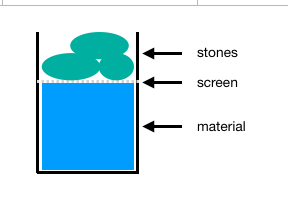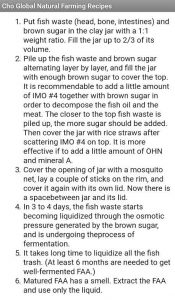I also have this effect happen to me when I ferment ripe banana fruit. I make KNF Food according to the recipe, but the banana material traps in the gasses more than other materials, so it will rise above the 2/3 mark and many times overflow.
To solve this problem, I place a metal screen over the material, then I place a few clean stones on top of that to weigh the material down so it will not rise when the gasses try to escape. 
It sounds like after 3 days the material is probably pretty well fermented? I would imagine your climate is relatively warm as from my research west africa is even closer to the equator than Hawaii. If there is a slight alcohol smell, that is tell tale that the fermentation is complete.
- drake answered 7 years ago
The KNF Fuel recipe does not change whether you are using fish or other land based animals. The concept is to use sugar to control the moisture content of the material so that it will slowly ferment and the microbes will have a chance to disassemble the proteins into amino acids. The primary microbe doing the fermentation of KNF Fuel is KNF Police and there is more detail to that in this answer.
There are benefits to using fish over other land based animals based on the oils that are present in fish such as omega fatty acid balance, etc.
The original textbook recipe does call for the addition of KNF Medicine and KNF Microbes, but in practice they have been found to be not mandatory. KNF Microbes are added to mitigate smell and are listed as optional, and KNF Medicine is to speed up the metabolization of the microbes to digest the meat a bit faster.
IMO2 is never called for in any official recipe and may be a mistake introduced by that instructor.
- drake answered 7 years ago
There are other reasons besides just preservation at room temperature to include the supersaturation of the KNF Food.
To answer your question, are they ruined? No. Are they degraded? Yes. In addition to vital enzymes and plant metabolites there are also a host of biological residents in the KNF Food. All of these degrade as fermentation continues beyond the initial arresting after extraction, albeit at a slower pace. The KNF Food will continue to transform the material as biology and chemistry dictate.
The presence of further alcohol in the solution is okay and still is indicative of the presence of yeast which is desired, but it is when this turns to vinegar that the biology has shifted to acetic acid bacteria and indicate a presence of much more bacteria, which mean much more of the vital stuff you want has degraded significantly.
One way I avoid this situation is to keep my preserved collections in preservation and then fill up a “working jar” with just enough for that month, usually blended with KNF Cleanser and KNF Medicine in the appropriate ratios so that I don’t have to carry around a bunch of jars, and if I forget it or spill it I am not loosing the farm so to speak.
- drake answered 7 years ago
The floor will work in this sort of scenario and keep your cute little pigs warm as they nestle with the microbes. I presently have 4 pens and only 3 pigs, so I rotate them around and leave one “fallow” for a while so I can harvest the BIO.
You may want to consider also spraying KNF Police with KNF Food on the pastures after you graze with the piggies. This will help break down their manure dropped in the field and stimulate the microbial population for richer growth. I use my boar as a tiller and follow him with this formula.
- drake answered 7 years ago
KNF Microbes can be collected in drought and in desert like conditions with ease, and it makes sense to do so, because you will be collecting drought tolerant microbes that will have added benefit to your region and changing climate conditions.
The key to this is to spray the area you would like to collect from with a formula containing
- KNF Medicine 1:1000
- KNF Food 1:500
- KNF Cleanser 1:500
- KNF Fuel 1:1000
If you do not have all the solutions, use what you have.
The formula is sprayed in a 6 foot radius around the area you would like to collect from for 5 days in the evening before your collection. Then once you set the box, you can spray once more around the box the following day, making sure not to spray directly on the box as you want the now very active and well fed microbes to actually make those last few inches to the box without taking the easy route of following the liquid you’ve deployed. This gets the most well adapted microbes to colonize your starch in the box.
The box should be set with the usual procedure.
Also when deploying the microbes after going through the cultivation procedure, it is extremely beneficial in a desert or drought prone area to be incorporating biochar into your practices. Just a few small nuggets of char can make a huge difference when placed by a new seedling or transplant. The microbes will use the char to hold water, and the electrical charge of the char also helps them to pump water in the soil.
There is a lot of water in the air in desert environments, and having the char in the soil with microbial life enables them to condensate the water out of the air and bring it into the soil as well as storing it in their bodies.
- drake answered 7 years ago
My plants have the virus but wont express the symptoms unless they are stressed. This stress comes from multiple things in my observation: too much rain, poor soil, not enough airflow, lack of minerals, etc. To quickly fix that i can employ knfPolice sprayed into the canopy where the leaves are bunching and also treat the surrounding soil especially with knfMicrobes and a good round of the soil treatment formula.
Ive had fully infected trees completely recover and now look just fine, and nobody would ever know it is present. However untreated or transplanted to a new area the expression will kill the plant.
Usually takes about 4 treatments once a week (ie 1 month of treatment) to see the new leaves come out without the bunchy look.
- drake answered 7 years ago
Cho has not taught the method for making the minerals outlined in his literature. He has said that a lab in Japan has the recipe and also produces it. Largely under testing the minerals vary widely from batch to batch and there is no consistency in the process or product. At one point I heard him talk about the alchemy of the process and how precious metals were involved, which led me to believe that it was some sort of consummation of the union between two rocks.
The way to make minerals in a home brew sort of way is to create a bacterial mineral water machine. The key is to load the machine with different types of rocks with sharp edges so when the falling water hits them, the minerals will be pulled into a solution. The official machine drops the water from 3 meters which puts enough acceleration into the water to really bludgeon the rocks, and as the water falls it tumbles and sucks in oxygen which also assists in the dissolution on a chemical level of thinking.
This youtube playlist has a lot of videos on the mineral solubilization machine.
- drake answered 7 years ago
Vomit, rotten eggs, fecal matter or dead body are all not good smells as they indicate the presence of pathogens that are not friendly to mammals.
ULC Microbes should be harvested early when the bubbles are most vigorous, if they are not, these smells will arise as the biology in the stew changes. Ideally it will smell sweet or something like sourdough bread.
- drake answered 7 years ago
In the text book there is a note under storage to keep it between 1-15 degrees Celsius.
If you have space to store the KNF Medicine in the fridge, that is ideal. Temperature fluctuations are not good for the solution which is bound with alcohol, and if you look at any place where wine or whiskey or similar are stored and brewed, they are always kept in dark caves or cellars. The fridge will also protect the solution from exposure to sunlight which is the quickest way to degrade the substance.
- drake answered 7 years ago
